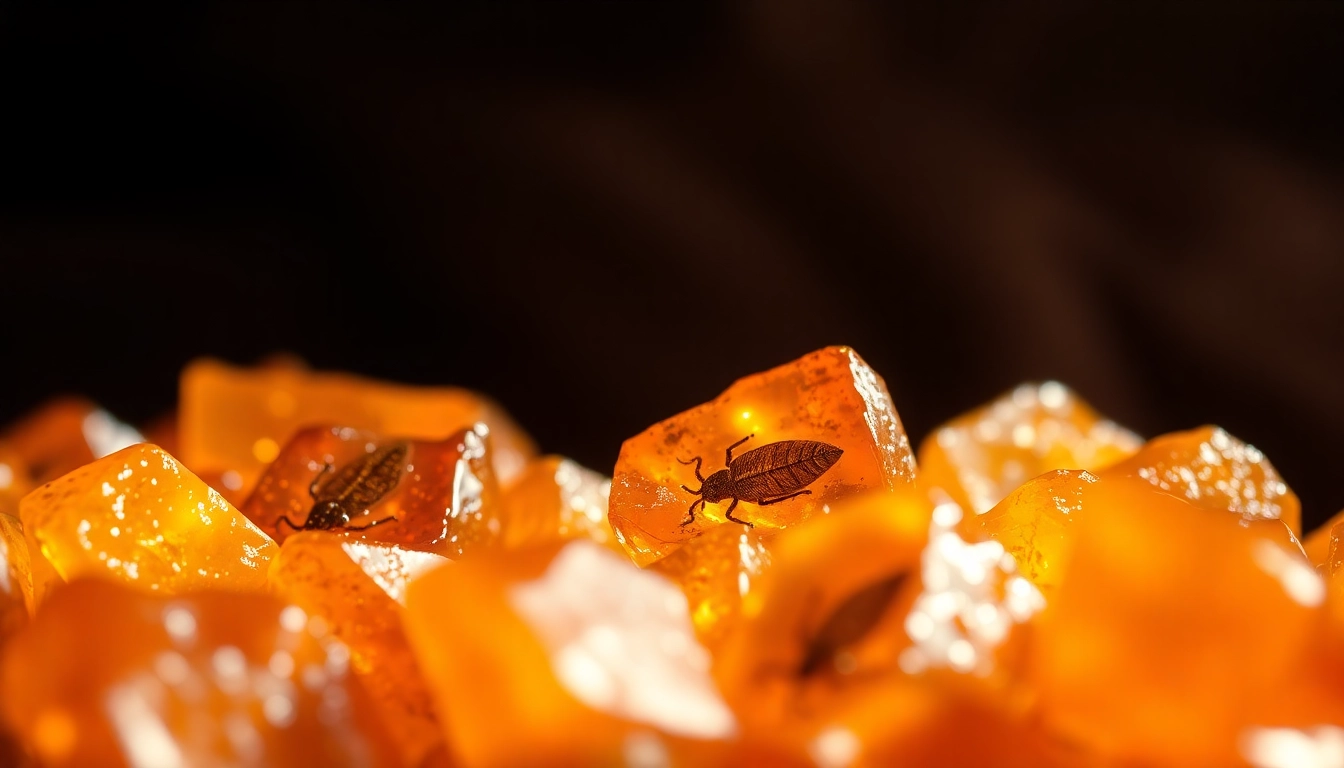The Allure of Amber: A Comprehensive Guide to Nature’s Gemstone

Understanding Amber: Nature’s Unique Gemstone
Amber, a beautiful and fascinating gemstone, is more than just a striking adornment; it is a window into the distant past. Often cherished for its warm hues and rich history, amber is technically fossilized tree resin that has captivated humans since the Neolithic era. Its vibrant colors and ability to encase ancient organic material make it a unique specimen in the world of gemstones. To learn more about this intriguing substance, explore the various aspects of amber, including its formation, types, cultural significance, and care practices.
What is Amber?
Amber is a fossilized tree resin originating from ancient trees, particularly conifers. Over millions of years, the resin undergoes a process of polymerization, which hardens it and enhances its stability. Unlike minerals, which are crystalline structures, amber is an organic material. Its mesmerizing shades range from yellow and orange to deep red and even green, creating an appealing gemstone cherished for jewelry and collectors alike.
The Formation Process of Amber
The journey of amber begins when resin, secreted by trees for protection against injury or disease, finds its way to the ground. The resin can become buried under layers of earth and over time undergoes chemical transformations due to heat and pressure. This slow process may last for millions of years, allowing the resin to lose volatile compounds and crystallize, yielding the amber we admire today. In addition to its fossilized form, many pieces of amber are notable for containing inclusions—fossilized insects, plants, and air bubbles from eons ago—offering a rare glimpse into the prehistoric environment.
Different Types of Amber and Their Characteristics
Amber comes in several varieties, each with distinct characteristics and origins. The most renowned types include:
- Baltic Amber: One of the most sought-after forms, Baltic amber is primarily found along the shores of the Baltic Sea. It is recognized for its large deposits and typical yellow to orange hues.
- Dominican Amber: Found in the Dominican Republic, this type is often clearer than Baltic amber and widely noted for its high-quality inclusions.
- Mexican Amber: Characterized by its deeper color variations, Mexican amber can take on hues ranging from yellow to deep red and is associated with various ancient cultures.
- Burmite Amber: Hailing from Myanmar, this amber is less common and famous for its rich golden color. Burmite often contains unique inclusions not found in other types of amber.
Each type of amber has unique qualities regarding appearance, inclusions, and uses in jewelry and crafts, contributing to its cultural and economic importance.
The Cultural Significance of Amber
Amber in Ancient Art and Jewelry
Historically, amber has played an important role in various cultures as both an art form and decorative item. The ancient Greeks referred to amber as “elektron,” deriving the word “electricity” from its ability to generate static when rubbed. It was highly valued in ancient times for its beauty and purported protective properties. This fascination with amber led to its widespread use in jewelry, from simple beads to intricate carvings in ancient civilizations like Rome and Egypt. Artifacts from Nobel patrons reveal that amber was frequently incorporated into crowns, adornments, and ceremonial objects.
Modern Uses of Amber in Wellness and Healing
Beyond ornamentation, amber is often celebrated in holistic healing practices. Many cultures believe that wearing amber can promote physical health and emotional well-being. It is said to have anti-inflammatory properties, making it a popular choice for teething babies when used in necklaces. Aromatherapy and massage therapists may use amber essential oils or powders in their practices to harness its soothing energies. However, while many individuals affirm the benefits of amber in wellness routines, medical evidence supporting these claims remains limited.
Folk Traditions and Beliefs Surrounding Amber
The allure of amber extends into societal beliefs; it has been associated with luck, protection, and healing across various cultures. In some traditions, amber was buried with the deceased to protect their souls in the afterlife, while others used it in talismans or amulets. In Slavic cultures, for example, amber was often regarded as a powerful protective charm against evil spirits. These beliefs have kept amber relevant, with artisans and spiritual leaders weaving its significance into modern practices.
How to Identify Authentic Amber
Distinguishing Real Amber from Imitations
With the popularity of amber, many imitations have flooded the market, primarily made from plastic or resin. To ensure authenticity, buyers must learn how to distinguish real amber from its synthetic counterparts. One method involves the “salt test”: placing the piece in saltwater; genuine amber should float while most fakes will sink. Additionally, amber has a distinct warm feel and a characteristic scent when heated, which synthetic materials do not possess.
Common Tests for Authenticity
Several rapid tests can help determine the authenticity of amber. The following methods are commonly used:
- UV Light Test: Under ultraviolet light, real amber fluoresces, often showing a yellow or blue glow, while most imitations do not.
- Visual Inspection: Look for natural irregularities and inclusions; amber pieces usually feature unique characteristics, whereas plastic imitations tend to be perfect and uniform.
- Static Electricity Test: Rubbing the piece on wool or hair can generate static. Real amber will attract small bits of paper or hair due to its electrostatic properties.
The Role of Inclusions in Value Assessment
Inclusions within amber significantly impact its value, making each piece an exceptional specimen. Fossilized insects, plant material, or air bubbles encapsulated in amber provide insight into Earth’s ecological past and can enhance the piece’s appeal for collectors. The rarity and condition of these inclusions often dictate the financial worth of the amber, with pieces containing perfectly preserved specimens fetching premium prices. Notably, amber with insects trapped inside is highly sought after, making it a valuable addition to any collection.
Caring for Amber Jewelry
Cleaning and Maintenance Tips
To ensure longevity and preserve the beauty of amber jewelry, proper care and maintenance are essential. Amber is relatively soft, rating between 2 and 2.5 on the Mohs hardness scale, making it susceptible to scratches and damage. The following tips will help maintain its charm:
- Gently clean amber with a soft, dry cloth; avoid using harsh chemicals or ultrasonic cleaners that can damage the surface.
- Keep amber jewelry away from excessive heat and direct sunlight, which can cause fading or warping.
- Store amber pieces in a soft pouch or jewelry box away from other harder gemstones to prevent scratching.
Storing Amber Properly to Preserve Quality
Amber should be stored carefully to maintain its integrity. When not in use, store amber jewelry in a cool, dark place, ideally in a fabric-lined box. Avoid storing with other jewelry pieces that may scratch or tarnish the amber. Alternatively, consider using a dedicated display case that allows for airflow while keeping dust and sunlight at bay.
Repairing Damaged Amber Pieces
Accidents happen, and amber is especially vulnerable to damage. If your amber jewelry becomes scratched or cracked, seek the expertise of a professional jeweler who specializes in amber restoration. Do-it-yourself repairs are generally not recommended, as improper techniques can further damage the piece or diminish its value. Expert restorers can skillfully mend cracks or polish out minor scratches, ensuring that your treasured jewelry remains exquisite.
Investing in Amber: Market Trends and Values
Understanding Amber’s Market Valuation
The amber market has experienced fluctuations in value due to various factors, including demand, provenance, and the specific type of amber. As interest in natural gemstones grows, so does the value of high-quality amber. Factors influencing prices include purity, size, and the presence of inclusions—especially those containing fossilized insects or rare plant material. Understanding these nuances is vital for prospective investors.
Future Trends in Amber Investments
As sustainability and natural products become increasingly sought after, amber’s appeal as a gemstone is projected to grow. Buyers worldwide are placing higher values on organic materials, thus increasing demand. Moreover, collectors are seeking out unique, rare pieces, driving prices higher. Additionally, as awareness about the importance of ethically sourced amber rises, buyers will pay a premium for pieces verified as responsibly harvested. This trend signals a promising future for amber investment.
Where to Buy High-Quality Amber
When considering a purchase of amber, sourcing from reputable dealers is crucial. Look for vendors who provide certification of authenticity and trace the origin of their amber. Established gemstone shows, galleries specializing in natural history, and trusted online resources are excellent places to discover high-quality amber pieces. Always consult knowledgeable sources before making a purchase to ensure that you acquire genuine amber that meets industry standards.



